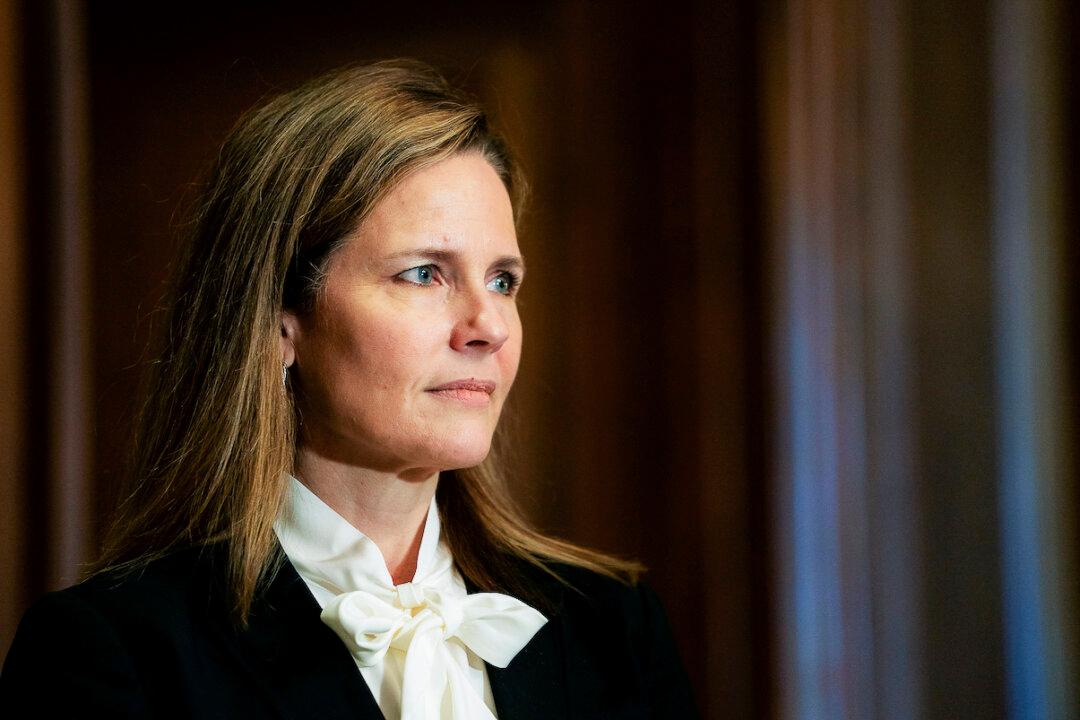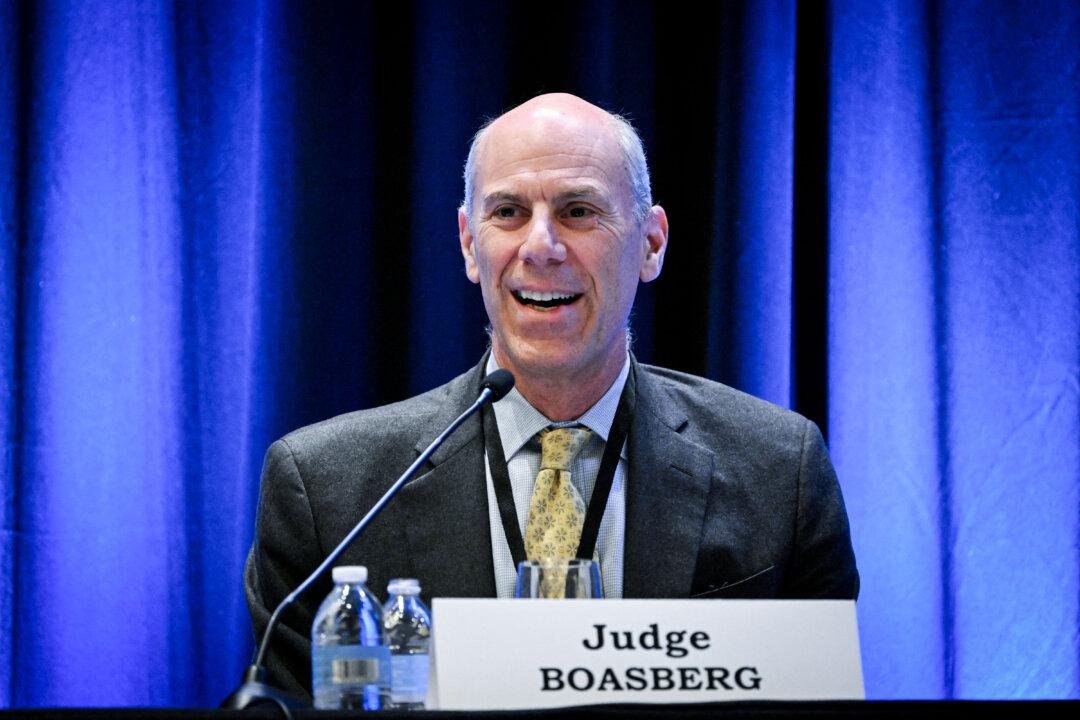The Supreme Court is set to hear its first oral argument of its upcoming term on Oct. 7 after releasing a series of hotly debated decisions this summer. The opinions in those cases have led to a flurry of media coverage and speculation that point to one justice, in particular, being the most watched in the coming term.
After just two terms on the court, Justice Amy Coney Barrett has become one of its most talked about members as she makes intriguing moves that break with her conservative colleagues and indicate an unpredictability for attorneys to study.
She was the last of former President Donald Trump’s nominees to the nation’s highest court, replacing liberal legend Ruth Bader Ginsburg and intensifying fears that American law will be durably skewed by a 6–3 conservative majority.
Her more recent decisions, however, have suggested she’s more of a swing vote in line with former Justice Sandra Day O’Connor rather than a conservative mainstay like Justice Clarence Thomas.
More specifically, she made statements indicating she wouldn’t blindly follow Republican interests or any particular view of the predominant judicial philosophy, originalism, among conservatives on the court.
Heritage Foundation Vice President John Malcolm told The Epoch Times: “Amy Coney Barrett is both an originalist and textualist, but in the more-cautious vein of Chief Justice Roberts and Justice Kavanaugh rather than the bold-strokes vein of Justices Thomas, Alito, and Gorsuch.”
Mixed Voting Record
Justice Barrett voted with her conservative colleagues in 6–3 decisions that upended longstanding precedent on abortion (Dobbs v. Jackson Women’s Health) and administrative law (Loper Bright Enterprises v. Raimondo).But when it came to weighing certain legal challenges that could affect Republican interests, she broke with her conservative colleagues. In its recent term, the court heard two major cases in which former President Donald Trump was a party and two others in which he was less directly implicated.
When the court released its decision in June, Justice Barrett issued a concurrence that was joined by the court’s liberals and revealed deeper fractures than one might expect from a unanimous decision.
She took aim at the court’s majority opinion, which was written by Justice Clarence Thomas. His approach to originalism in that case, she said, was “wrong twice over” and suggested that it overemphasized the role of historical comparison. Justice Thomas had argued that a “firm grounding in traditional trademark law is sufficient to justify the content-based trademark restriction here.”
Justice Barrett argued the court should do more than simply look at whether the law had a historical analog. Instead, she said: “I would adopt a standard, grounded in both trademark law and First Amendment precedent, that reflects the relationship between content-based trademark registration restrictions and free speech.” She added that “the absence of founding era evidence does not mean that content-based trademark registration restrictions are inherently suspect.”
Justice Thomas, who authored the opinion in Bruen, was the lone dissenter in Rahimi and argued that “not a single historical regulation” justified a federal law prohibiting possession among domestic abusers.
Limited Opinions for Trump
Before her second term, both she and another Trump appointee, Justice Brett Kavanaugh, were among those who declined to hear a Republican-brought lawsuit related to the 2020 presidential election.“Particularly in this circumstance, writings on the Court should turn the national temperature down, not up,” she said in an apparent jab at the liberal justices’ concurrence written by Justice Sonia Sotomayor. Justice Sotomayor had chastised the majority by saying among other things, that it attempted “to insulate all alleged insurrectionists from future challenges to their holding federal office.”
Justice Barrett agreed with the liberal justices’ conclusion that the majority went too far in specifying that Congress must be the one to enforce Section 3 of the 14th Amendment, which bars insurrectionists from holding office. Justice Barrett wasn’t specific on enforcement while the three liberal justices indicated federal courts could enforce the provision.
She is somewhat unique in that most of her legal career prior to joining the court was in academia. Other justices like Justices Ketanji Brown Jackson, Sotomayor, and Samuel Alito spent considerable time as judges in various federal circuits.
Prior to joining the Supreme Court in 2020, Justice Barrett joined the U.S. Court of Appeals for the 7th Circuit in 2017. She also spent time clerking for federal judges, including former Justice Antonin Scalia.
Former Michigan Solicitor General John Bursch told The Epoch Times that “when you spent all of your life as a professor, and only two years on the court of appeals, you might have a tendency to require perfection from cases procedurally before they get to you at the Supreme Court.”
Immunity and Jan. 6
Two of the most-watched decisions from the term also showed her diverging from her conservative colleagues on cases involving Jan. 6.In July, she agreed with her conservative colleagues in upholding criminal immunity for Trump but did so in a more limited way than they did.
Chief Justice John Roberts wrote in the majority opinion that allowing juries to consider that evidence would defeat the purpose of immunity.
“That proposal threatens to eviscerate the immunity we have recognized,” he said. “It would permit a prosecutor to do indirectly what he cannot do directly—invite the jury to examine acts for which a President is immune from prosecution to nonetheless prove his liability on any charge.”
That decision emanated from Trump’s ongoing election interference case in Washington, where he is charged in relation to various activities leading up to and on Jan. 6, 2021.
In that decision, Justice Barrett swapped with her liberal colleague, Justice Jackson, and wrote the dissent with the backing of Justice Sotomayor and Justice Elena Kagan. She accused Justice Jackson and the court’s conservatives of doing “textual backflips” to avoid letting the statute apply to Jan. 6 defendants.
The majority, which included each of the five other conservative justices, held that prosecutors had to do more to sufficiently allege a section of the law prohibiting obstruction of an official proceeding.






